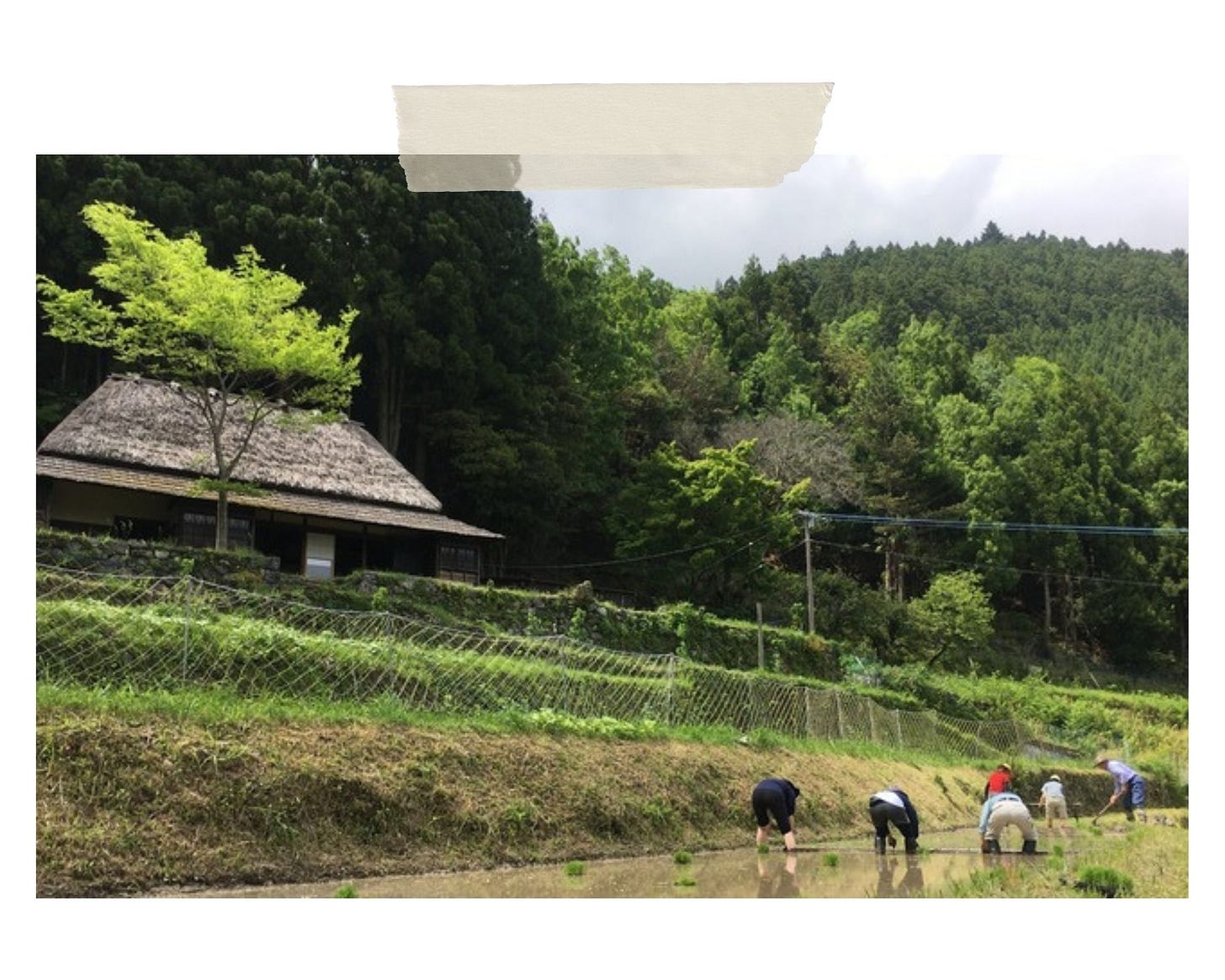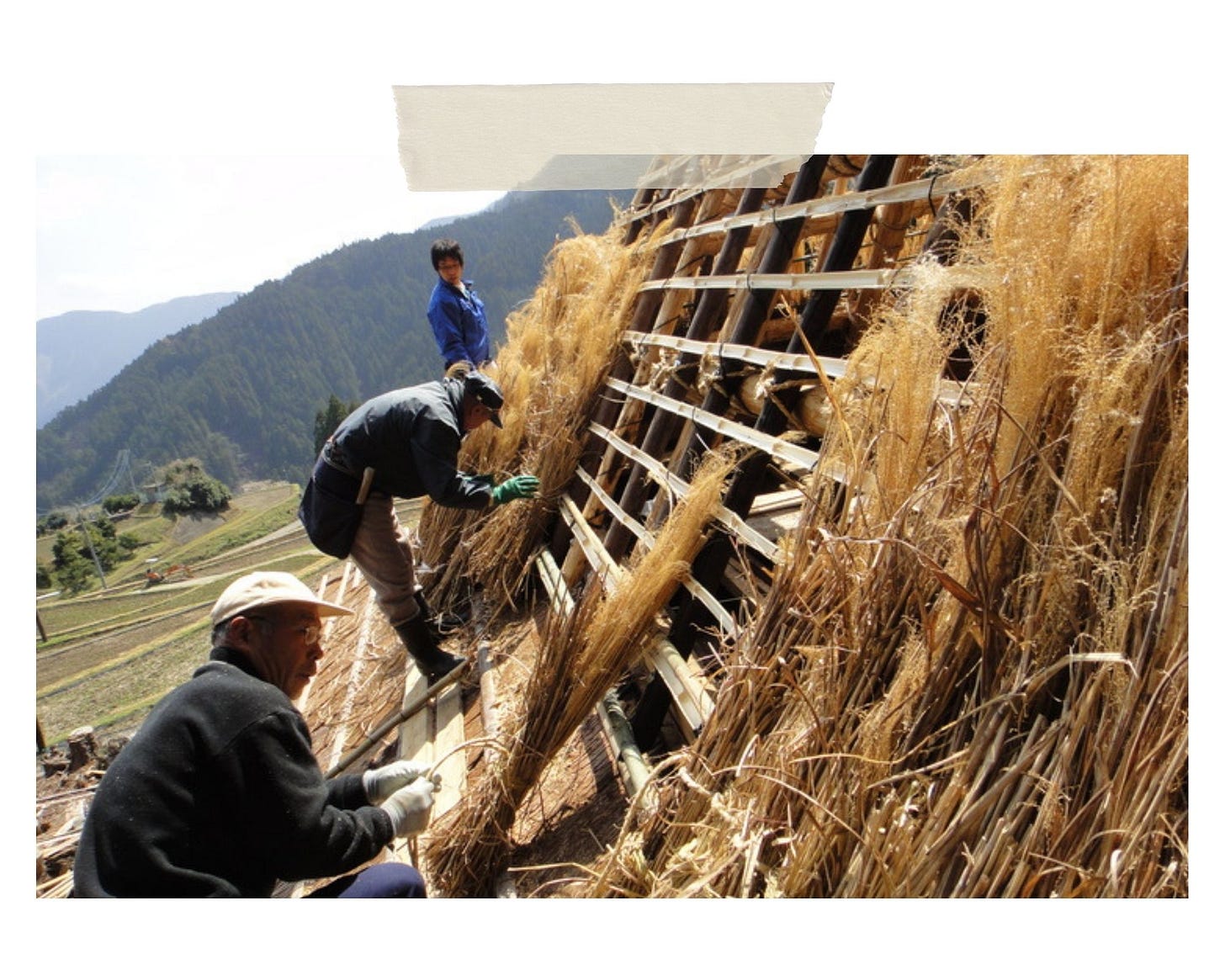Kamikatsu’s Last Thatched House
The importance of protecting 'old'
Dear friends,
Thank you for the kindness and feedback on my first letter of 2022. Every time someone tells me they read the newsletter, I feel deeply grateful. I’m glad that parts of it resonated with you or sparked your interest.
This week, I begin with a question: Why do we value things? A broad question, I know. But more specifically—why do we value old things?
This letter is, in part, an appreciation of cultural heritage and traditional architecture. It’s also a small request to support a project I’ll explain later.
I was born in Toronto, the capital of Ontario, Canada. Like many cities, it’s a dynamic metropolis, its skyline dominated by soaring skyscrapers. I grew up surrounded by modern architecture—concrete, steel, and glass—lots of tall, shiny buildings, and lots of greys. In the suburban neighbourhoods where I spent my childhood, nearly identical brick houses stretched in neat rows. To me, it all felt… unremarkable.
I didn’t grow up seeing old buildings. Of course, what qualifies as old is relative, depending on where you’re from and the history of your surroundings. It wasn’t until I started travelling that I truly felt the meaning of cultural heritage through architecture. While Toronto certainly has historic and culturally significant buildings, I struggled to see them in the same light as the remarkable places I encountered abroad.
Since moving to Japan, I’ve been amazed at how casually people reference the age of buildings. 50 years, young. 100 year, still (possibly) young. Temples, shrines, and relics dating back hundreds—sometimes thousands—of years are meticulously preserved, woven seamlessly into daily life.
It was only when I stood before architecture far older than anything I had ever seen in Canada that I began to understand how built spaces hold meaning beyond their physical forms. As architect Juhani Pallasmaa once wrote, “The significance of architecture is not in its form, but in its capacity to reveal deeper layers of existence.”
A symbol of community
Perched atop the mountains in the Yaeji region stands Kamikatsu’s last remaining kayabuki (thatched-roof) house. While Japan is home to well-known villages where entire communities of thatched houses still exist, in Kamikatsu, only one remains.
Kayabuki refers to a traditional roofing technique using kaya (grass). Depending on the materials used, it’s sometimes called straw-thatching or grass-thatching. Thatched roofs can be found across Japan, each with distinct characteristics in materials, ridge shape, and thatching methods.
But why is this important? Why does it matter that a very old house, a former private residence, could be on the brink of disappearing? This circles back to the earlier question I asked myself, ‘Why do we value (old) things?’
To answer that, we need to consider the meaning of cultural heritage—a concept I became familiar with during my master’s program. Heritage refers to what is inherited from past generations, while cultural heritage signifies something that belongs to a community. It serves as a marker of history and identity. Even the natural environment is considered cultural heritage, as landscapes shape the identity of the people who live there. Cultural heritage isn’t just tangible—it also includes oral traditions, craftsmanship, and skills passed down through generations.
I believe the kayabuki house is an essential part of Kamikatsu’s cultural heritage, a symbol of the community’s past. Old architecture like this carries collective memory, history, and identity—it deepens our understanding of who we are. While this isn’t my personal history or culture, I have the privilege of spending time in this place, and through that experience, I gain a deeper connection to Kamikatsu.
Temagai Spirit
The very brief history of the house was that it was owned by the Hanano family and constructed as a typical farmhouse of that time. Over time the house became abandoned and a group of local people decided to repair the house, including replacing the thatched roof. The roofing was not done by professional thatchers but by local people using materials procured in the area and based on the methods they used when they were young.
In the past, villagers would come together to maintain each other’s thatched roofs, working in succession—"this house this year, that house next year." This culture of mutual aid and shared labour is called temagai in Kamikatsu. Instead of exchanging money, people repaid each other through work, strengthening community bonds.
Today, with only one kayabuki (thatched-roof) house left in town, there is no longer a network of thatchers to replace its roof. When the house underwent restoration in 2012, it was only possible thanks to the dedication of elders who had inherited the craft and the generosity of volunteers who contributed their labour.
The last remaining kayabuki house is now being managed by the “Kamikatsu Thatched School” (かみかつ茅葺き学校), which is an organization that provides experiences and lessons of traditional life at the kayabuki house. In Japan, thatched houses are often designated as cultural assets, and in many situations, people are only allowed to observe them as they would an art piece in a museum. However, this kayabuki house is a space that can be used freely and is meant to be enjoyed.
The Kamikatsu Thatched School calls itself a “school” because it is a place of learning. Here, people can gain knowledge about farming, forestry, and fishing, as well as the wisdom essential for mountain life. For the elderly, it is a rare and meaningful opportunity to pass down their skills, experiences, and traditions—preserving the intangible cultural heritage of Kamikatsu.
Lastly, re-thatching the roof is an expensive and necessary endeavour to maintain the structure. The market price for replacing a thatched roof is said to be about 15-20 million yen (~175,000 USD), but the Kayabuki School was able to source a contractor that will guide the re-thatching for about 2 million yen (~13,000 USD).
There has been a fundraising campaign that started a while ago but will only be open for 3 more days.
I was really happy to help the fundraising campaign by translating their page into English. So if you’re interested in reading more about the history and background, please check it out. And of course, if you feel at all inclined to give, please consider!
To once again quote Juhani Pallasmaa: “There is tacit wisdom of architecture accumulated in history and tradition. But in today’s panicked rush for the new, we rarely stop to listen to this wisdom.”
To preserve an old building is to honour the memories and wisdom of those who came before us, and so much of the cultural heritage is lost when we lose an old building. There is knowledge embedded in our architecture—the lessons, skills, and histories of people who gave shape to a shared identity.
Happy Sunday or Monday, wherever you are. May you move through this new week with compassion for yourself and those around you.
Continue to stay warm! I’m writing from a very cozy home and hope you’re feeling warmth too.
With love,
Kana






